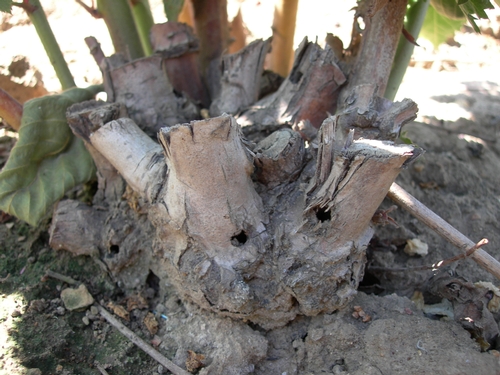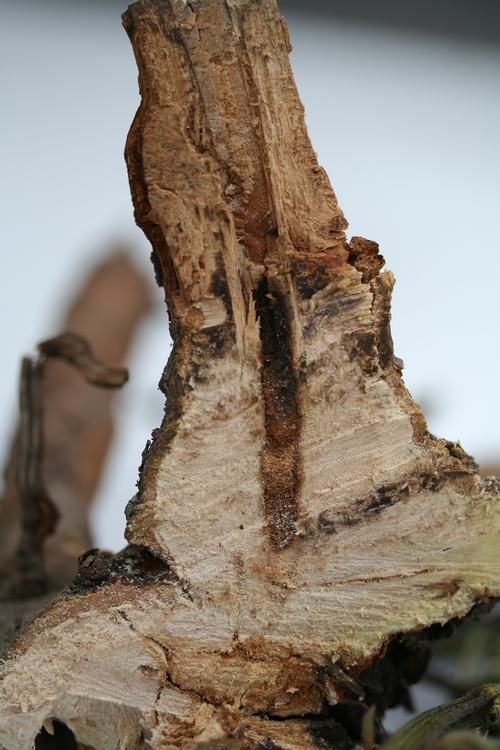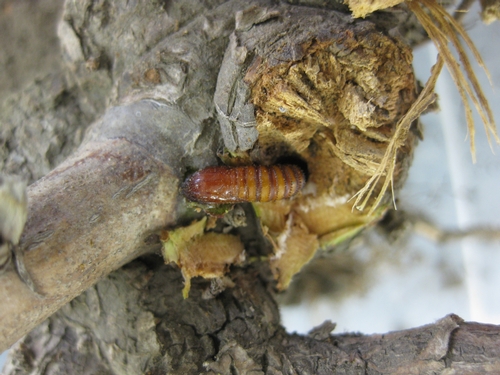Posts Tagged: raspberry crown borer
A Primer on Raspberry Crown Borer in Blackberry
There have been a few reports as of late concerning a rather abrupt wilting of blackberry plants in certain fields. Some of these wilts have been found to be caused by raspberry crown borer, which merits a discussion of this pest in this space.
Crown borer is actually simple to diagnose in the field. One will notice a rather pronounced wilt of the plant, and a subsequent evaluation of the crown of the plant will find a hole there, usually with some sawdust like material deposited outside. Excavation and opening this section of the plant will find significant tunneling and usually a rather large larva of a half an inch or longer in length, which of course explains the wilt, since most of the water conducting elements are ruined by all this activity and no longer functioning in bringing water higher up to the plant.
As the reader can see from the picture below, crown borer adults look a lot like a wasp, but they are not. They are a clearwing moth that looks like a wasp to protect it from predation. Note the long antenna and extensive scales on the individual that distinguish it from a regular wasp in the picture below.
Briefly, the life cycle of crown borer is two years long. It appears that the adults are active here in Watsonville in late June and so they would be laying their red-brown eggs on the undersides of leaves around this time as well. Larvae, after emerging from the eggs somewhere in the area of a month later, work their way down the cane, where they either find a place in the bark to hide or begin excavating a tunnel in the crown. In either case, the larva is not embedded in the cane yet and rather shallowly situated. The larva continues to tunnel into the crown through the following year, by the time which the damage can be quite extensive. Late in the summer, the larva must go into pupation, a state which it apparently remains in until the following spring. There is unfortunately no degree day model available for raspberry crown borer yet- this would be an exceedingly useful tool, since we are able to use pheromone traps to detect emerging adults and would be able to count with fair accuracy when the susceptible larvae are emerging and working their way down the cane.
A test using drenches at the base of the cane (Johnson and Kim, 2011. The Bramble pp 8-9) found that Brigade, Assail and Entrust all reduced the amount of crown borer in infested caneberries. Altacor, also registered in caneberries, has also been recommended for crown borer but it is not clear how well this worked in controlling them. These applications are a function of how closely one is to getting the small, superficially hidden larvae of the first year after they hatch. The deeply embedded larvae of the second year would be near impossible to get to and kill, by my estimation.
It is still my recommendation that crown borer infested plants be removed immediately from the field and destroyed. I have yet to see an infestation that is extensive in a field, so plant removal is essentially rouging and keeping the populations of this still rather infrequent pest in check rather than reducing yield by large scale plant removal. This is important, since blackberry plantations tend to be long lived, and maintaining them as clear as possible of crown borer is a good step in the direction of maintaining long term field viability.
There are pesticides mentioned for management of raspberry crown borers in this article. Before using any of these products, check with your local Agricultural Commissioner's Office and consult product labels for current status of product registration, restrictions, and use information.
Thank you to Chris Matthews and Doyle Goins for their assistance with the information for this article.

Tunnel entrances typical of raspberry crown borer

Cross section of raspberry crown borer tunnel. Notice how large and extensive this is- unsurprisingly water flow is interrupted here.

Caneberry borer pupa. Photo courtesy Mansun Kong, Driscoll's Strawberry Associates

Raspberry crown borer adult in pheromone trap. Look at the chunky body structure and scales. Also of note is the lengthy antenna typical of moths.

Wasp or hornet caught in same pheromone trap as above. Note short, club-like antenna, and slender transition from thorax to abdomen. No scales either.

